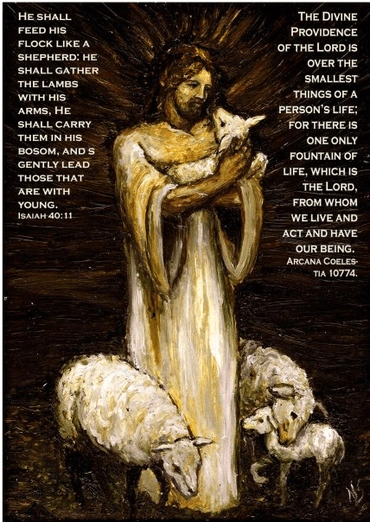
What does the Bible say about its own inner meaning?
Some people take most of what the Bible says very literally. Others see the Bible as being largely symbolic, with a deeper meaning. Sometimes a conflict arises between the two different points of view. One side insists that any search for a deeper meaning comes from a failure to believe what God plainly says. The other side claims that it is only by means of the symbolic interpretation that the Bible becomes meaningful and relevant for today.
The question of how to interpret the Bible shouldn't just be a matter of personal opinion. Regardless of whether we prefer a literal or symbolic interpretation, it makes sense to look at how the Bible interprets itself. How does God tell us to interpret His revelation? Does He indicate that we should look for a deeper meaning?
Jesus said that all the Law and the Prophets hang upon the Two Great Commandments, to love the Lord and to love the neighbor. But some parts of the Bible don't seem to say anything about loving God and others. Do these parts of the Bible actually have hidden meanings that teach us how to love?
Jesus explained that the commandment about murder shouldn't be taken just on a literal level. On a deeper level, it prohibits hatred and contempt. "You have heard that it was said to those of old, You shall not murder,'...But I say to you that whoever is angry with his brother without a cause shall be in danger of the judgment." (Matthew 5:21-22)
Likewise, the deeper meaning of the commandment against adultery prohibits lust. "You have heard that it was said to those of old, You shall not commit adultery,' But I say to you that whoever looks at a woman to lust for her has already committed adultery with her in his heart." (Matthew 5:27-28)
Jesus frequently showed that the Old Testament contained deeper meanings than were first apparent. For example, He told His disciples that the Old Testament contained many prophecies about His own life that they had not understood.
"Beginning at Moses and all the Prophets, He expounded to them in all the Scriptures the things concerning Himself." (Luke 24:27)
"He opened their understanding that they might comprehend the Scriptures." (Luke 24:45)
Jesus showed that stories in the Old Testament were symbolic of His own life, even when the symbolism was not apparent in the literal meaning. For example, the story of the manna is symbolic of Jesus as the bread of life: "Moses did not give you the bread from heaven, but My Father gives you the true bread from heaven." (John 6:32)
Another story with an inner meaning referring to Jesus is the brass serpent: "As Moses lifted up the serpent in the wilderness, even so must the Son of Man be lifted up." (John 3:14)
It is similar with the story of Jonah and the whale: "As Jonah was three days in the belly of the great fish, so will the Son of Man be three days and three nights in the heart of the earth." (Matthew 12:40)
The temple in Jerusalem, which was the scene of many stories in the Old Testament, was also a symbol of Jesus. (John 2:19-22)
In his letters to the early Christian congregations, Paul also encourages us to go beyond the literal meaning of the Old Testament. He asks us to obey the spirit of the law, not just the letter. "He is a Jew who is one inwardly, and circumcision is that of the heart, in the Spirit, and not in the letter." (Romans 2:29)
"We should serve in the newness of the Spirit and not in the oldness of the letter." (Romans 7:6)
"The letter kills, but the spirit gives life." (2 Corinthians 3:6)
Paul often pointed to deeper meanings in the Old Testament. For example, he took Adam as a symbol of Christ, (Romans 5:14) and his marriage with Eve as a symbol of Christ's marriage with the Church. (Ephesians 5:31, 32)
The Tabernacle of Israel with its furnishings and all the rituals and sacrifices performed in it pictured Jesus' work of salvation. These earthly things were the "copy and shadow of heavenly things...symbolic for the present time." (Hebrews 8:5, 9:9, Colossians 2:16, 17) The story of Abraham, Sarah, and Hagar and their sons is also an allegory, in which Hagar's son represented the Lord's covenant with the Jews and Sarah's son symbolized the New Covenant in Christ. (Galatians 4:22-31)
The apostle Peter saw the story of Noah and the Flood as an antitype of baptism and regeneration. (1 Peter 3:20-21)
The Exodus story tells how the children of Israel escaped from Egypt, trekked through the wilderness for forty years, and finally made their home in the promised land. Many have seen this as symbolic of our spiritual journey out of slavery to sin, through trials and temptations and into heaven. But does the Bible itself suggest that this is a parable, or a story with an inner meaning? In fact, it does. Psalm 78 opens with the words, "I will open my mouth in a parable; I will utter dark sayings of old." (Psalms 78:1).
The "parable" that follows is the story of the plagues on Egypt, crossing the Red Sea, bringing water from the rock, receiving manna from heaven, and other stories of the Exodus. Thus the whole story of Exodus is a parable.
The prophet Hosea wrote, "When Israel was a child, I loved him, and out of Egypt I called My son." (Hosea 11:1)
Clearly, the "child" here is Israel as a young nation, and being called out of Egypt refers to the Exodus. But on a deeper level, it refers to Christ Himself — it is prophetic of what would happen in Jesus' life. (Matthew 2:15)
We can see from this that many of the stories of the Old Testament are symbolic of Christ and His work of salvation. But what about the stories that are not directly explained in the New Testament? Do they also have inner meanings? Many people have seen a parallel between Joseph, the son of Israel, and Jesus. The Bible itself never says specifically that the story of Joseph has an inner meaning relating to Christ. But here's a list that illustrates how Joseph was a symbol of Christ, even though this symbolism could not have been seen before Christ's coming.
Joseph and Jesus Compared:
- Joseph was a shepherd; Jesus was our Shepherd
- Joseph was a beloved son; Jesus was a beloved Son
- Joseph was stripped of his tunic; Jesus was stripped of His tunic
- Joseph was sold for twenty pieces of silver by Judah; Jesus was betrayed for thirty pieces of silver by Judas
- Joseph was abandoned by his brothers; Jesus was abandoned by His disciples
- Joseph was falsely accused of crime; Jesus was falsely accused of crime
- Joseph was imprisoned with two criminals, one of whom would be released; Jesus was crucified with two criminals, one of whom would be saved
- Joseph was became ruler of all the land; Jesus became King of heaven
- Joseph provided food to hungry people; Jesus provided food to hungry people
- Joseph was reunited with his brothers, who bowed down to him; Jesus was reunited with His disciples, who worshipped Him
- Joseph was reunited with his father; Jesus was reunited with the Father in Him
May we look for a deeper meaning even in places which the Bible does not specifically explain? We have already seen that Christ fulfilled many prophecies that were symbolically hidden in Old Testament stories. Does every part of the Law and Prophets contain prophecies of Jesus life? Jesus said, "Do not think that I came to destroy the Law or the Prophets. I did not come to destroy but to fulfill. For assuredly, I say to you, till heaven and earth pass away, one jot or one tittle will by no means pass from the law till all is fulfilled." If Jesus fulfilled every jot and tittle of the Law and Prophets, then every jot and tittle must contain prophecies of His life, either symbolically hidden or clearly stated.
So far we have focused on the Old Testament. What about the New Testament? Does it also contain inner meanings? Jesus constantly spoke in parables: "Without a parable He did not speak to them." (Matthew 13:34)
He told us that He would eventually reveal to us the inner meaning of His words.
"I still have many things to say to you, but you cannot bear them now.... These things I have spoken to you in figurative language; but the time is coming when I will no longer speak to you in figurative language but I will tell you plainly about the Father." (John 16:12, 25)
What about the Book of Revelation? Many things in this book seem obviously to be symbolic. For example, this book speaks of Four Horsemen, one on a white horse, one on a red one, one on a black one, and one called Death on a pale horse. Most people can see that these are not literal horses, but symbols of something else, such as war, famine and plague. (Revelation 6:1-8)
Most people realize that the holy city New Jerusalem is a symbol of heaven or of a new era on earth, and not a literal city a thousand miles high coming out of the clouds.
If the Book of Revelation is at all like the prophecies of the Old Testament, it must contain many prophecies hidden in symbolism that become clear only after the prophesied events have taken place.
The Bible is God's revelation of Himself. As a Divine Revelation, the Bible contains infinite truth. In order to see that truth more fully, we must look for the deeper meanings to which the Bible itself points us. If we do this, the Lord will "open our eyes to see wonderful things from His law" so that we can more and more clearly see the Lord Himself revealed in "every jot and tittle."
Author: Rev. John Odhner. Used by permission.









